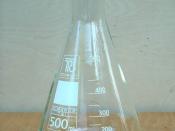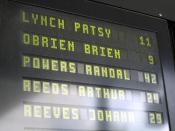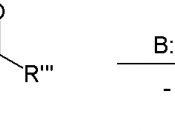The goal of this experiment was to synthesize dibenzalacetone by aldol synthesis. The name 'Aldol synthesis' was taken from the words 'aldehyde and alcohol'. This is because the product of this reaction contains both an aldehyde and alcohol. The carbon-carbon bond-forming reaction is referred to as aldol addition. An aldol condensation yields many species of products if the reactant is more than one. Therefore, the aldehyde has to react with itself to yield one product.
Procedure: Followed according to the lab manual.
Results:DataValueWeight of crude crystal1.6 gWeight of recrystallization crystal0.48 gColor of crystalOrange-yellow% recovery of recrystallization:(0.48 g)/(1.6 g) ÃÂ100 %=30%Theoretical yield (from prelab): 1.177 gPercent yield(0.48 g)/(1.177 g) ÃÂ100 %=40.78%âÂÂConclusionThrough this experiment, aldehyde reacts with itself in the presence of acetone and base, NaOH. Acetone is used as the enolate forming compound, adding to the benzaldehyde followed by the dehydration to form a benzal group. As for the low yield (40.78%),
it can be attributed to a few factors. The first being that this reaction goes by an equilibrium and that if this was not shifted far enough to the dibenzalacetone side, the reaction would not go to completion and less yield can be expected. It might be caused by the solvent used during recrystallization was a little bit more than advised in the lab manual (~15 mL instead of ~12 mL of ethanol). The crystal, (I'm afraid if) it would be solved beyond recrystallizing at this point; but it recrystallized as it cools down, so I was sure that the solvent used was not too much. The crystal was also wasted in the Erlenmeyer flask and some on the filter paper used to dry it.
IR analysisThe IR result from this experiment shows no significant stretches infrequency higher than 2000 cm-1 except for a trough at 3052.68 cm-1 that...


